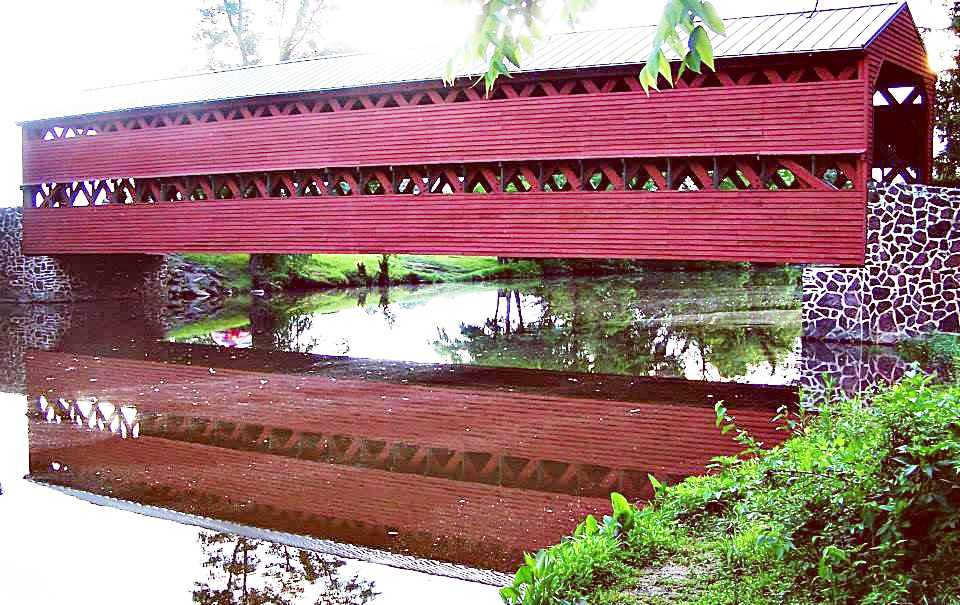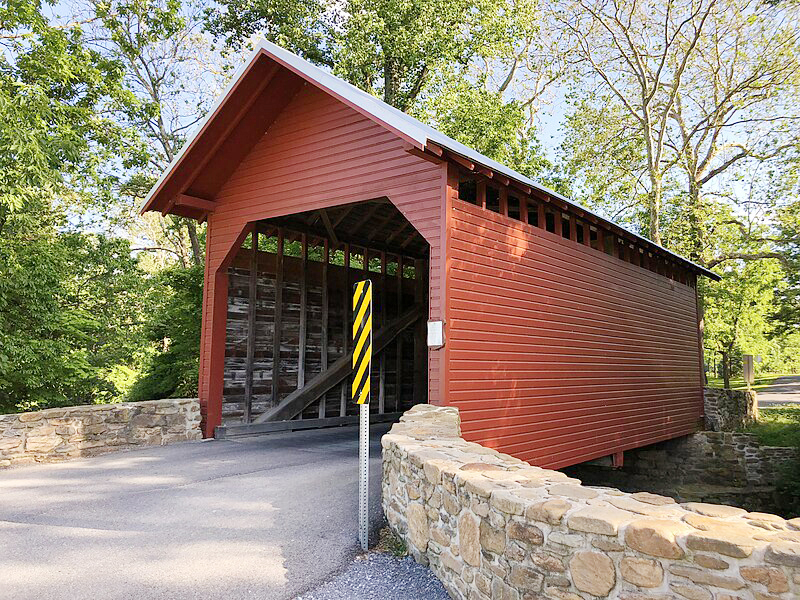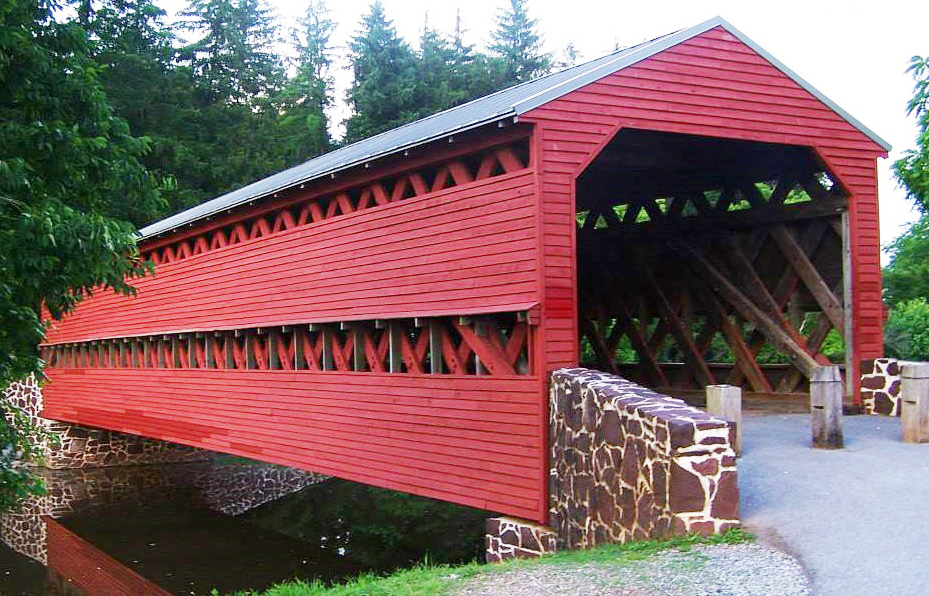
Mason-Dixon Covered Bridges

Richard D. L. Fulton
For decades, covered bridges, seemingly having been located in the most idyllic locations, have mesmerized writers, artists, photographers, tourists, and the countless casual observers.
But covered bridges were never erected with a pleasant setting or with architectural aesthetics in mind, and much in the way of misconception as to their origin and reason for even existing, has, at times, supplanted the facts.
Where did they decide to build these bridges and why? Why did they even attach roofs on the bridges?
“In the beginning,” before the proliferation of bridges during the Age of the Horse and Buggy, the primary means to get from one side of a stream to another was generally accomplished at a ford, where the water level was generally low enough to permit crossing.
However, fords could prove to be especially hazardous during stormy weather, which caused the water levels to rise along with the velocity of the water. Many bridges were initially constructed based on the number of drownings or near-drownings that had taken place at any given ford.
Subsequently, wooden bridges were also erected to provide a shortcut if the distance between the fords was overly excessive.
The first bridges were simple, uncovered structures. The floorboards, support, and side beams (called trusses) were subject to deterioration caused by rain and snow, as well as alternating freezes and thaws, thus resulting in continuous work on the bridges in order to maintain their integrity.
The first American “covered bridges” appeared in the 1700s when bridge engineers realized that the lifespan of a wooden bridges’ construct could be substantially increased if the side beams (truss work) could be sheathed in wood. In other words, the siding would take the brunt of the impact of adverse weather, in place of the actual support structure of the bridge.
However, before jumping to the conclusion that this is when the traditional roofed covered bridge concept was born, well, it was at least a beginning, because the first covered bridges had only their sides sheathed in planking, but they did not have a roof. Instead, each side had a peaked cap.
These were called “boxed bridges,” of which few have survived to be seen today (one of the longest surviving boxed bridges exists in the Ralph Stover State Park in Bucks County, Pennsylvania.
However, as bridge engineering evolved, so did the development of the truss work that held them up. Yet, these new truss designs required the sides to be higher, and if only the sides were sheathed, this would have made them especially susceptible to collapsing in high winds.
The only obvious solution was to provide crossbeams to keep the sides upright. It was also determined that if a roof was added, it would further stabilize the entire structure. This “revelation” is generally credited to Swiss and German bridge engineers.
Thus, the true covered bridge was born, and the fact that the sheathing would prolong the life of the bridge far exceeded even their initial projections. Some of these bridges are still around and continue to be utilized by modern traffic 150 years after their original construction (some had steel beams added to their undersides to help with the added weight of modern-day vehicles).
The first true covered bridge was the Market Street Covered Bridge erected in 1805 in Philadelphia. After that, hundreds were constructed over rivers and streams in numerous states (some erected in the South were constructed without the side-sheathing… apparently, they “didn’t get the memo.”).
Why do they all resemble barns? While the covered bridges were often designed by bridge engineers, most of them were erected by local barn-builders and woodworkers, so the mutual appearance is by no means merely coincidental!
Why are they always painted red or white? The bridges, like so many local farm buildings themselves, were painted according to the cheapest pigments available. Red paint was used where iron oxides (such as limonite) were readily available (white was sometimes added on the portals so that the locations of the sides could be readily recognized in the dark or during severe weather). White paint was used where lime was more abundant (cheaper).
It should be noted here that “covered bridges” actually appeared during “Biblical times,” throughout Asia and Europe, but they were generally constructed of stone, with a roof added to enable the bridges to further double as indoor marketplaces.
Contrary to popular folklore, the bridges were not sheathed and covered to keep horses from panicking during a crossing. Not only was this never even a consideration, but those in the south where the sides weren’t sheathed, further dismissed that.
Another popular belief was that the bridges were sheathed and roofed to keep snow out. But, in fact, during winter weather, locals would form bucket brigades to “snow the bridge.” If there was no snow inside the bridge, the blades of the horse-drawn sleds would have torn the floorboards up.
So, how did they come to be called “kissing bridges?” Given the frequency of the carved initials of apparently young couples left in the wooden beams of many of the more secluded covered bridges, the reason is better left to the imagination.
By the end of the 1800s, iron and steel had replaced the wood in the construction of bridges, and America’s covered bridges began to gradually vanish, due to their having become the victims of obsoletion, floods, fire and arson, or abandonment.
The Roddy Road Covered Bridge is 40 feet long, 16 feet wide, with a 12-foot-8-inch clearance, built in 1856.
Sachs Covered Bridge, erected in 1854, is located off Pumping Station Road in Adams County, PA
List of Publicly Accessible Covered Bridges in Frederick and Adams Counties
Frederick County Covered Bridges
During the 1800s, there were more than 50 covered bridges that had been erected within Frederick County.
Loy’s Station Covered Bridge was erected in 1880. The 90-foot-long bridge is located where Old Frederick Road spans Owen’s Creek, near Thurmont. The bridge was damaged in an act of arson in 1991, but was subsequently restored.

Roddy Road Covered Bridge was constructed in 1856, and, as the name suggests, carries Roddy Road over Owens Creek, also near Thurmont. The 40-foot-long bridge was repaired in 1993 after an oversized truck damaged it.
Utica Mills Covered Bridge, also constructed in 1850, and today carries Utica Mills Road over Fishing Creek. “Today” is used in reference to the 100-foot-long bridge, which was relocated to its present location from its original location on the Monocacy River after it was destroyed in a flood in 1889.
Adams County Covered Bridges
During the 1800s, there were more than 70 covered bridges that had been erected in Adams County.
Jack’s Mountain Covered Bridge was built in 1890 and conveys Jack’s Mountain Road over Toms Creek near Fairfield. The 75-foot-long bridge is the only covered bridge in Adams County permitting vehicular traffic.

Sachs Covered Bridge, erected in 1854, spans Marsh Creek, and is located within a park located off Pumping Station Road. The 100-foot-long bridge survived the Battle of Gettysburg, but was completely destroyed in a severe flood in 1996. Much of the original wooden beams and other structures were recovered and subsequently incorporated into the rebuilt bridge. The bridge is open to the public. However, vehicles are forbidden to cross.
